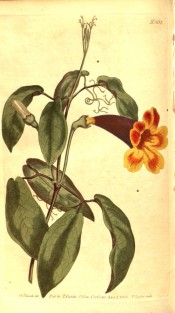Bignonia capreolata L.
Half hardy vigorous climber with opposite leaves to 18cm long, usually consisting of 2 leaflets and 1 tendril. Orange-red flowers are borne in summer. To 10m or more. [RHSE, Hilliers’, Hortus].
Horticultural & Botanical History
‘This, with many more [species of Bignonia] is a climber; it seems however better adapted to raise itself among the branches of underwood than to ascend the trunks of lofty trees, for it does not put forth at its joints roots capable of insinuating themselves into the bark, as Bignonia radicans does, but supports itself by its footstalks and tendrils, which clasp round whatever plant or twig may happen to be near.’ [BM t.864/1805].
‘A native of woods on the banks of rivers and lakes from Virginia to Florida. It is an elegant climbing plant.’ [LBC no.714/1823].
‘The error […] in the culture of this plant, when grown in the open air, is the shortening of the shoots after the specimen has attained a flowering age. By such means, it is always kept growing, and producing a quantity of vigorous but infertile lateral branches; whereas, by leaving the shoots to depend naturally from the principal stems, superabundant development is avoided, and the production of flowers follows.’ [MB p.245/1841]. Possibly introduced to Europe as early as 1653 [Hilliers’] or 1710 [PD].
History at Camden Park
Listed in all published catalogues [T.155/1843].
Notes
Published Feb 27, 2009 - 03:24 PM | Last updated Jul 15, 2010 - 10:38 AM
| Family | Bignoniaceae |
|---|---|
| Category | |
| Region of origin | South eastern USA |
| Synonyms |
|
| Common Name | Cross vine |
| Name in the Camden Park Record | Bignonia capreolata |
| Confidence level | high |


